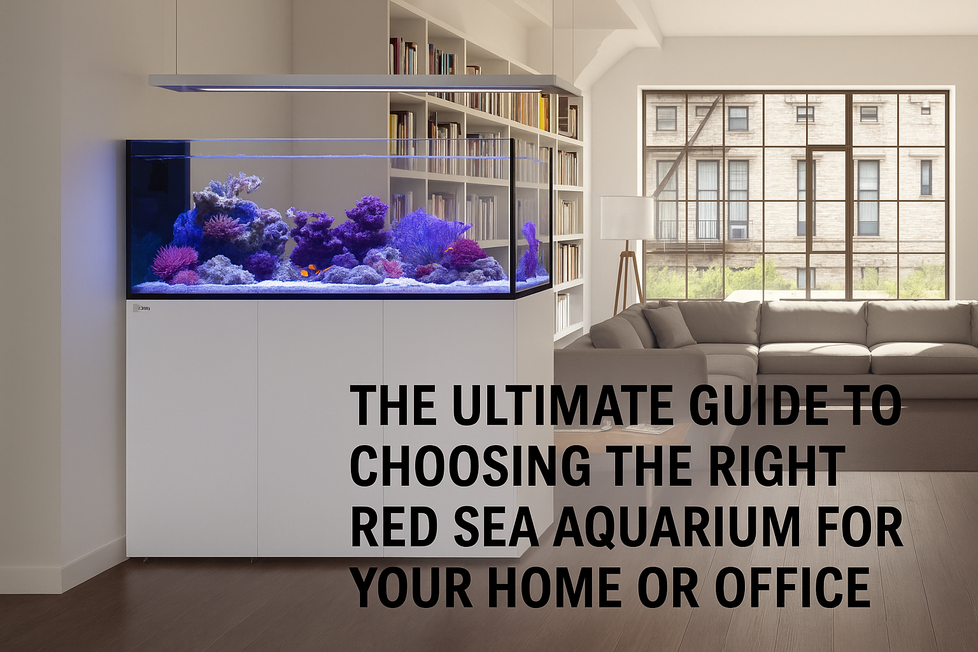Starting a reef aquarium can seem like a daunting task, but with the right tools and supplies, it’s a fun and rewarding hobby. Whether you're a complete newbie or transitioning from freshwater to saltwater, this guide will help you get all the essentials. So, sit back, relax, and let's dive into the ultimate shopping list for beginner reef keepers. We'll reference some top-notch products from Charterhouse Aquatics to help you build your perfect reef tank.
Why Start a Reef Tank?
Reef aquariums are not only beautiful to look at, but they also create a miniature ecosystem that can be both relaxing and educational. Watching corals grow and marine fish thrive can bring a lot of joy and a sense of accomplishment.
The Essential Shopping List
1. The Tank
Choosing the right tank is the first step. For beginners, a 20-30 gallon tank is a good starting point, large enough to maintain stable water conditions but small enough to manage maintenance easily.
Recommended Product: Red Sea Max Nano XL
2. Protein Skimmer
A protein skimmer is essential for maintaining water quality by removing organic waste before it breaks down into harmful substances. If you are a beginner, it can be a VERY valuable piece of kit.
Recommended Product: Fluval Sea PS2 Mini Protein Skimmer
3. Lighting
Proper lighting is essential for coral growth. LED lights are energy-efficient and provide the necessary spectrum for photosynthesis. Reef lights might seems expensive at first for an 'aquarium light', but a reliable unit will play a big part in you successfully growing your first coral.
Recommended Product: AI Prime HD LED
4. Live Rock and Substrate
Live rock is not only decorative but also provides a surface for beneficial bacteria to colonize. Aragonite sand is a great substrate option that helps maintain proper pH levels, some of these even come seeded with beneficial bacteria.
Recommended Products:
5. Powerheads
Powerheads or flow pumps are essential for creating water movement, which is vital for coral health, gas exchange & for moving food around the aquarium, particularly for corals.
Recommended Product: EcoTech Marine VorTech MP10
6. Heater
Maintaining a stable temperature is crucial for a reef tank. A reliable heater will ensure your marine creatures stay comfortable.
Recommended Product: Eheim Thermo Electronic Heater
7. Test Kits
Regularly testing your water is key to a healthy reef. A comprehensive test kit will help you monitor essential parameters like pH, ammonia, nitrite, and nitrate levels as well as key parameters needed for healthy coral growth.
Recommended Product: API Reef Master Test Kit
8. Salt Mix
Marine salt mix is necessary to create the perfect saltwater environment for your reef tank. Look for a high-quality mix that includes all the essential foundation minerals and trace elements.
Recommended Product: Red Sea Coral Pro
9. Refractometer
A refractometer is a precise tool for measuring the salinity of your aquarium water, ensuring it remains at the optimal level for your marine inhabitants.
Recommended Product: D-D H2Ocean Refractometer
10. Supplements
Corals and other invertebrates require additional supplements to thrive. Calcium, magnesium, and alkalinity buffers are essential for maintaining healthy growth.
Recommended Product: Red Sea Reef Foundation ABC+
Setting Up Your Reef Aquarium
Step 1: Assemble Your Equipment
Start by setting up your tank, stand, and any equipment that needs to be attached or installed. This includes your filter, protein skimmer, heater, and power heads.
Step 2: Add Substrate and Live Rock
Rinse your substrate before adding it to the tank (if the manufacturer advises). Then aquascape your live rock in an appealing and stable arrangement. The live rock will act as the foundation for your reef.
Step 3: Mix Your Saltwater
Use your marine salt mix to prepare the saltwater. Follow the instructions on the salt mix packaging to achieve the correct salinity. Use your refractometer to ensure accuracy.
Step 4: Fill the Tank
Slowly fill your tank with the prepared saltwater, taking care not to disturb the substrate and live rock.
Step 5: Start the Filtration and Heating
Turn on your filter, protein skimmer, powerheads, and heater. Set the heater to maintain a temperature of around 25°C (77°F).
Step 6: Cycle Your Tank
You can use a bottle beneficial bacteria to kick start your cycling process, there are some very good tank starters and bacterias on the market now that can gie you a great start in a very short space of time
Recommended product - Fritz Turbo Start
Step 7: Test Your Water
Regularly test your water during the cycling process. Once ammonia and nitrite levels are zero and nitrates are low, your tank is ready for inhabitants.
Adding Livestock
Start with hardy fish and invertebrates. Introduce them slowly to avoid overwhelming your biological filter. Some beginner-friendly choices include:
- Clownfish
- Damselfish
- Hermit Crabs
- Snails
Maintenance Tips
- Regular Water Changes: Perform a 10-20% water change weekly to maintain water quality.
- Monitor Parameters: Keep a close eye on your water parameters and adjust as needed.
- Feed Sparingly: Overfeeding can lead to poor water quality. Feed your fish small amounts once or twice a day.
Conclusion
Starting a reef aquarium doesn't have to be intimidating. With the right equipment and a bit of patience, you'll create a thriving underwater ecosystem that brings endless joy and fascination.
If you have any questions or need more tips, don’t hesitate to explore more on Charterhouse Aquatics or reach out to our customer service team who are more than happy to help.


